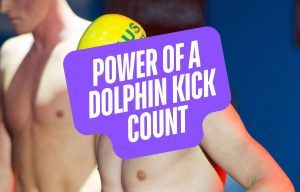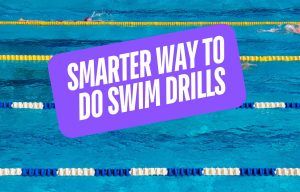Looking for a set to train and predict 100m freestyle performance? Here’s a classic set for preparing the exact skills for fast sprinting on race day.
Sprint sets are fairly simple: dive into the water, swim your brains out, rest a bunch, and repeat.
But what makes a sprint set go from good to great is when they do double duty:
- The set trains the exact same energy systems and technique specific to your event
- Provides useful feedback about race-readiness.
One of the classic sprint sets used by elite swimmers and programs—4×50 fast with around 2 minutes rest per repetition—does exactly this.
It “overreaches” the same energy systems for sustained sprinting and your performance on the set is a strong indicator of how well you can swim the full 100 freestyle fast.
Let’s take a looky look.
The Study: 4x50m Race Pace vs. 100m Freestyle Performance
A recent study by Terzi et al. (2021) published in the Journal of Human Kinetics and titled “Relevance of a Sprint Interval Swim Training Set to the 100-Meter Freestyle Event Based on Blood Lactate and Kinematic Variables” tested whether 4x50m all out could be a reliable predictor on 100m freestyle performance.
See also: 7 Types of Interval Training Workouts for Faster Swimming
Researchers had 27 experienced competitive swimmers do two different sets on different days to ensure maximal effort:
- A max effort 100m freestyle time trial
- A 4x50m freestyle sprint set, all-out, using a 1:4 work-to-rest ratio
With each effort in the pool, they measured all the important stuff, including:
- Swimming velocity
- Blood lactate (a measure of anaerobic output and fatigue tolerance)
- Stroke rate
- Stroke Index (speed x distance per stroke—measures efficiency)
How the Race Pace Set Correlated to Improved 100m Freestyle Times
Here is how things shook out:
| Variable | 4x50m (M) | 100m Free (M) | 4x50m (F) | 100m Free (F) |
| Swim Speed (m/s) | 1.72 | 1.66 | 1.55 | 1.5 |
| Blood Lactate (mmol/L) | 14.1 | 10 | 15.3 | 11.6 |
| Stroke Rate (cycles/min) | 48.8 | 45.1 | 45.9 | 44.1 |
| Stroke Index (m²/cycle/s) | 3.65 | 3.68 | 3.17 | 3.07 |
Faster swim speeds
Swimmers held a faster average swimming velocity during the 4×50 versus the 100m time trial.
- For male swimmers, the average speed in the 4x50m set was 1.72 m/s compared to 1.66 m/s in the 100m. This was an increase of about 3.6%.
- For the female swimmers, the average speed in the 4×50m set was 1.55 m/s compared to 1.50 m/s in the 100m. An increase of about 3.3%.
This shows that the shorter reps and longer recovery periods allowed swimmers to sustain higher velocities than they could hold over the full 100m.
💡 Why this matters: Practicing at speeds at or faster than your race pace helps train your neuromuscular system to recruit more muscle fibers quickly, and builds the confidence to know you can swim fast on race day.
Improved time trial performance
Perhaps not a huge surprise, but swimmers who did well on the 4x50m set were the same ones who kicked butt in the 100m free time trial. The correlations were pretty significant:
- Speed: r = 0.93
- Stroke Index: r = 0.94
- Stroke Rate: r = 0.84
- Blood Lactate: r = 0.64
Basically, if you can do well on this set, you are in the right kind of “shape” to crush a 100m freestyle, too.
Lots of lactate = more race-ready
Swimmers have a lot of competition in the pool when sprinting, between the distracting thoughts under their swim cap and swimmers in the next lane sprinting out to an early lead.
And then there’s the effects of lactate, which swimmers contend with as their anaerobic system works hard to create energy.
This set is excellent for teaching the body how to tolerate lactate. Levels were significantly higher after the 4x50m set compared to the 100m freestyle.
- Males: Blood lactate was about 41% higher after the 4×50m set than the 100m freestyle (14.1 vs. 10.0 mmol/L).
- Females: Blood lactate was about 32% higher after the 4×50m set than the 100m freestyle (15.3 vs. 11.6 mmol/L).
Increased lactate levels are not a bad thing. It’s exactly what we want from a training stimulus.
Higher lactate means your body is being pushed harder than you can manage in a single, flat-out 100m, building the tolerance and power you’ll need to hold top speed when it counts.
Higher quality strokes
During the 50s, swimmers held higher stroke rates and maintained good stroke efficiency (as measured by stroke index).
A higher stroke rate is a good sign (in this case)—it’s tough to sustain in competition and even harder to train for extended periods in practice. Breaking the work into shorter 50s allows swimmers to hit and hold those faster turnover rates for longer than they could in one continuous effort.
The set also promoted a technically sound, fast stroke, as swimmers maintained good stroke efficiency even when working at maximum effort.
Can be used as a race readiness indicator
The set checks all the boxes for race-specific training. Lots of lactate, fast stroke rate, enough rest to maintain technique.
That means you aren’t just working “hard” or flailing around and getting a good sweat in. You’re swimming like a smarty-pants, with clear biomechanical relevance to your goals.
Use the set from time to time to check in on your readiness. It can be helpful for showing how ready you are at this stage of training, and whether you might need more upfront speed or fatigue resistance training to help you close more rapidly.
The Bottom Line
Sprint sets don’t have to be complicated, but the best ones are designed with an eye towards building the performance you want on race day.
The 4x50m sprint set is simple, brutal, and incredibly useful for improving and assessing 100m freestyle performance. It overloads the exact energy systems and technical demands of a blistering 100m freestyle.
And it can give you a reliable gut check on where your training currently sits, and where you can improve, whether it’s front-end speed, technique, or fatigue tolerance (but hopefully not all three 😉).
Use the set regularly over the course of the season to build race day confidence, train smarter, and measure progress.
Happy sprinting!












